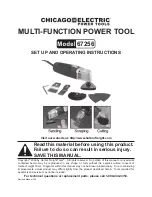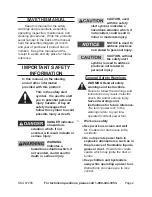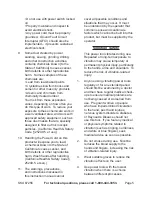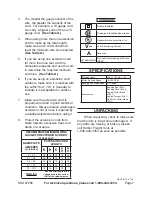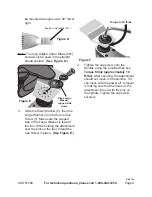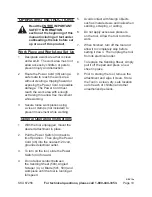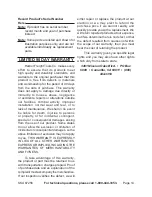
SKU 67256
For technical questions, please call 1-800-444-3353.
Page 3
Electrical safety
2.
Power tool Plugs must match the
a.
outlet. Never modify the Plug in
any way. do not use any adapter
plugs with grounded power tools.
Unmodified plugs and matching
outlets will reduce risk of electric
shock.
avoid body contact with grounded
b.
surfaces such as pipes, radiators,
ranges and refrigerators.
There is
an increased risk of electric shock if
your body is grounded.
do not expose power tools to rain
c.
or wet conditions.
Water entering
a power tool will increase the risk of
electric shock.
do not abuse the Power Cord.
d.
Never use the Cord for carrying,
pulling or unplugging the power
tool. Keep Cord away from
heat, oil, sharp edges or moving
parts.
Damaged or entangled cords
increase the risk of electric shock.
When operating a power tool
e.
outdoors, use an extension cord
suitable for outdoor use.
Use of a
cord suitable for outdoor use reduces
the risk of electric shock.
If operating a power tool in a damp
f.
location is unavoidable, use a
ground Fault Circuit Interrupter
(gFCI) protected supply.
Use of
a GFCI reduces the risk of electric
shock.
Personal safety
3.
Stay alert, watch what you are
a.
doing and use common sense
when operating a power tool. do
not use a power tool while you
are tired or under the influence of
drugs, alcohol or medication.
A
moment of inattention while operating
power tools may result in serious
personal injury.
Use personal protective
b.
equipment. always wear aNSI-
approved safety goggles.
Safety
equipment such as NIOSH-approved
dust mask/respirator, NIOSH-
approved hearing protection, and
heavy duty work gloves will reduce
personal injuries.
Prevent unintentional starting.
c.
Ensure the Power Switch is in the
off-position before connecting to
the power source or picking up or
carrying the tool.
Carrying power
tools with your finger on the Power
Switch invites accidents.
Remove any adjusting key or
d.
wrench before turning the power
tool on.
A wrench or a key left
attached to an oscillating part of the
power tool may result in personal
injury.
do not overreach. Keep proper
e.
footing and balance at all times.
This enables better control of the
power tool in unexpected situations.
dress properly. do not wear loose
f.
clothing or jewelry. Keep your
hair, clothing and gloves away
from moving parts.
Loose clothes,
jewelry or long hair can be caught in
moving parts.
Power tool use and care
4.
do not force the power tool. Use
a.
the correct power tool for your
application.
The correct power tool
will do the job better and safer at the
rate for which it was designed.
do not use the power tool if the
b.
Power Switch does not turn it on

